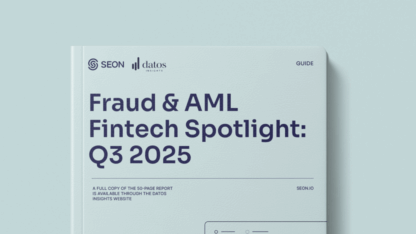With fraud alone estimated to cost the global economy $3.7 trillion a year, and the current state of money laundering, which touches two to five percent of the global GDP, the financial impact of these crimes is staggering.
On June 25, industry peers and leaders gathered for a webinar moderated by Christina Brichetto, Senior Product Marketing Manager at SEON. Guest panelists included James Nurse, Managing Director at FINTRAIL; Hannah Becher, Lead of Fraud and AML Surveillance at Pleo; Matthew Tataryn, Director of Financial Crime Risk at Tide Platform; and Jeremy Doyle, Director of Growth, AML Solutions at SEON. The webinar recording – available to watch here – thoroughly examined the importance of collaboration between fraud prevention and anti-money laundering (AML) teams. The conversation highlighted key strategies, regulatory trends and technological advancements that enable organizations to stay one step ahead.
The panelists discussed the complexities and benefits of integrating fraud and AML teams, the challenges in scaling operations and the current global money laundering regulations. The critical need for AI-driven decision-making processes alongside human oversight was also emphasized. Below are the top takeaways from the discussion:
1. Overcoming Communication Barriers in Fraud and AML Integration
One of the critical challenges is the lack of effective communication and clear ownership between teams, which presents a major hurdle in prevention efforts. This issue stems from the differing terminologies and investigative approaches fraud and AML teams use. Many organizations want to break down the barriers between teams to help improve efficiency and the effectiveness of compliance operations, and there is interest in how technology can help support this endeavor through unified systems and intelligence to encourage better cross-department collaboration.
“Historically, there may have been some hesitancy [to combine teams] due to different priorities and responsibilities. However, effective communication and clear ownership can bridge this gap. Fraud and AML investigations often overlap, and having investigators skilled in both areas can streamline processes and improve outcomes.”
– Matt Tataryn
“We’ve recently combined our fraud and AML teams. We see synergies, especially in escalating high-risk cases. Having one system is crucial to avoid language barriers and improve collaboration.”
– Hannah Beecher
2. Navigating New Regulatory Landscapes in Financial Compliance
Regulators worldwide are making significant updates to ensure predicate offenses related to AML and fraud are reflected in regulations to keep up with evolving threats. Specifically, PSD3 is on the radar of many European fintechs, emphasizing fraud prevention and collaboration. Likewise, ISO/IEC 42001 and the upcoming EU AI Act are driving best practices in the ethical application of AI through explainability, transparency, data governance and enhanced record-keeping.
“Companies must remain adaptable, updating governance and compliance frameworks to keep pace with regulatory changes. Leveraging technology, particularly AI, while ensuring transparency and explainability is key. Organizations must proactively shape strategies to stay competitive despite the evolving regulatory landscape.”
– Jeremy Doyle
“The revision of PSD3 and the upcoming EU AI Act are crucial. These regulations will enhance security measures, transparency, and documentation requirements for AI models. To comply with these regulations, we must ensure human oversight and detailed documentation.”
– Hannah Beecher
3. Enhancing Fraud & AML Detection Through Quality Data and AI
Data quality is integral to fraud and money laundering detection. Leveraging AI and machine learning can boost collaborative efforts by reducing costs and automating manual processes like KYC and transaction monitoring. However, it is crucial to understand that the output of machine learning models is only as good as the data input. High-quality, accurate data ensures that these models can effectively identify and respond to fraudulent activities.
These technologies should be deployed to tackle specific challenges in proportion to the size and scope of the problem. A focused approach, supported by quality data, will enable departments to fully realize the benefits of advanced technologies and give confidence to expand to broader use cases.
“It’s all about harnessing the potential, which brings me back to the common phrase, garbage in, garbage out. Data quality and data governance are really key foundations for being able to implement [AI and machine learning initiatives in fraud detection and AML.]”
– Hannah Beecher“Grounding data around the customer and using integrated platforms for shared intelligence is vital. This approach helps teams make informed decisions and fosters collaboration.”
– Jeremy Doyle
4. Technology as a Productivity Enabler
Centralizing data around the customer and surfacing information through an integrated platform allows financial crime prevention teams to keep fraud and AML expertise separate or bring them closer together. In both scenarios, providing teams with a unified system of record that bridges gaps and allows for intelligence to be easily shared in context with the customer’s behavior will be one of the critical enablers in driving collaboration and productivity between fraud and AML teams.
“Anomaly detection is a great way in which machine learning can be used specifically around fraud.”
– Matt Tataryn“We implemented AI to help us to automatically triangulate information, speeding up the review process and enhancing decision-making.”
– Hannah Beecher
Enhancing Financial Crime Prevention
As the regulatory landscape evolves, staying ahead with proactive strategies and continuous improvement will be crucial to success. Organizations can significantly enhance their financial crime prevention efforts by leveraging technology and fostering a culture of shared intelligence. We look forward to continuing these critical conversations and driving impactful change in the fight against financial crime.
Equip your team with the knowledge and tools to excel.
Download Guide
Sources:








